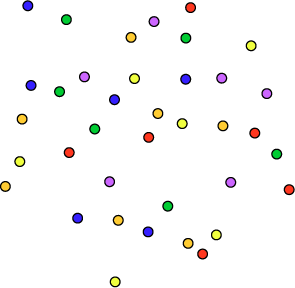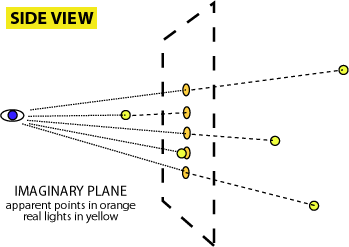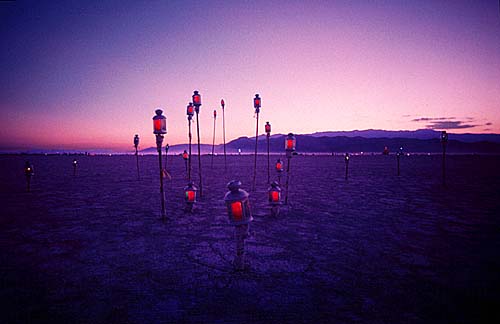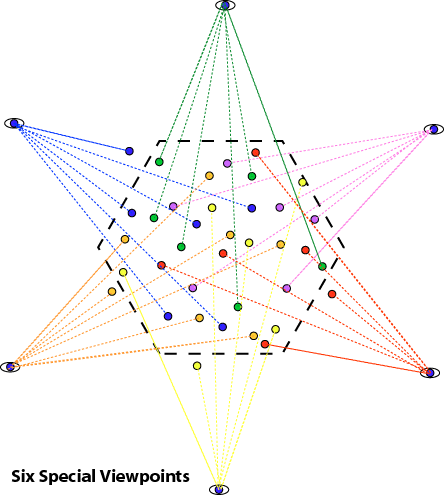|
|
 |
 |
 |
|
| m
(luminous constellations) |
 |
|
|
This
page describes a theme-related art installation for Burning
Man 2004.
Implementation
details are at the bottom of the page.
Please write me with any
questions or call me anytime at (415) 487-9439 (home),
(415) 637-5347 (cell).
|
|
|
| encountering
the galaxy |
|
|
|
Far
out on the playa, a field of subtly-colored lanterns is encounted.
The lanterns are silent, suspended on bamboo poles at various
hights. From afar they blend into the flickering lights of
our carnival city, and the twinkling stars above. Up close
the flicker of their small lights creates a gently wash of
color on the playa.
The lights
are spread seemingly at random over an area of perhaps forty
feet in diameter. Seen from above, the installation would
look something ike this:

Each
lantern is mounted on a bamboo pole at a height varying from
close to the ground to a maximum of 8'.
Each
lantern and has six facets, many of which are covered with
gels so that the light cast is colored.
The gently
flicker light is not particularly bright; at night, it casts
a soft colored aurora on the playa below it. On the deep playa,
this is more than sufficient to create a place that is welcoming
and alive. The lanterns are fixed on bamboo poles, apparently
by rope... the overall feel is austere but natural, plain
but warm, beautiful and quiet. The last two years, similar
installations of ours were described as peaceful, serene,
a refuge, and Hobbiton-like.
There
is a clear ordering to the arrangement of lanterns in space.
Circled on foot or on bikes, it becomes clear that the lanterns
are almost all on arranged a plain at a gentle angle to the
playa, on one end nearly touching it and 6'-8' on the other
side, an angle of about 10-15 degrees. The density of lanterns
is highest in the center of the group, and there lanters form
a central mass, distending out from the implied plain.
On close
examination, the lanterns are seen to create a five-armed
spiral galaxy, mirroring those invisible above. The lanters
are stars, providing an opportunity to float among a cozy,
human-scaled galaxy.
<PICTURE
COMING - RSI problems delayed>
|
|
|
| inspiration
for the piece |
|
|
|
One
of my favorite aspects of the playa is how it strips space
of its scale references. Illusions and mysteries of scale
abound -- how far is it, anyway, to that sculpture? How big
is that thing over there?
At night
in particular, small point sources of light are very hard
to fix in space. A bright light six feet away and thirty feet
away look quite similar. Is that light a dropped glow stick,
or a rave, or a whole installation I missed...?
My installations
that past few years have played more conceptula games with
this aspect of the space. This year I considered a satisfactory
final cerebral extension of the themes of the past few years,
but I decided ultimately that the aspect most important to
me right now is the creation of a welcoming, safe space.
As a result,
while I intend as in past years to inject a careful ordering
of the lamps' placement to create an effect as described below,
the primary goal this year is simply to create a recognizable
celestial object, a galaxy, on an inviting and welcoming scale.
I would like the materials and form to speak for themselves
and to acknowledge the wonders of the universe, rather than
concentrating on a more intellectual game that dilutes the
actual experience of place (as I had originally conceived).
Nonetheless,
I look forward to imbedding in the galaxy at least one recognizable
form, picked out in color, as described below; perhaps the
clear figure of Orion, lying on his side; or perhaps, simply
a red circle, as with my pieces the last two years, that inscribe
a figure around the distant Man when viewed from the correct
perspective.
Regardless
of what figure I intentionally embed in the lantern arrangement,
the real point and joy of encountering the piece will be the
visceral experience of moving around a three-dimensional array
of lanterns and seeing that as they shift in relation to one
another, constellations are made and dissolve -- a reminder
that our view on the universe above is a result of our relative
stasis, not grand design.
I hope
that my piece will reveal its own 'milky way' banding of dense
light, but we'll have to see on the playa.
I describe
the principal of constellation that will be used to embed
intentional and unintentional figures below.
|
|
|
| principles
of constellations |
|
|
|
Coherence
-- regularity, alignment, color -- forces the viewer to perceive
the lights as a group, even though they are scattered in space.
Humans are very good at detecting patterns and regularity.
Consider
the situation of the viewer below:

The
yellow circles show where objects (lanterns) are really placed,
at varying distances from the viewer, at various heights..
From our
perspective, looking from the side, they're all over the
place, a random distribution.
But to
the viewer on the left, the lights line up in a neat line.
It's easy to see how the viewer will group them, unconciously,
if they're neatly spaced -- even if that neatness is an "accident'
of a specific perspective, a trick of lines of sight, at a
unique viewpoint.
The key
is that at one viewpoint, s/he doesn't care that some of the
lights are closer than others. We could slide the lights closer
or farther to the viewer, anywhere along the dotted line axes,
without upsetting the perceived line.
Another
example of this principal is how how constellations work:

Whatever
constellation I embed in the 'galaxy' I build, will be constructed
on just these principals: it will only be visible from one
specific perspective.
|
|
|
|
PRIOR
ART: Burning Man 2002: sign of light
|
|
|
|
These
ideas were all realized last year in my installation for the
deep playa, Sign
of Light, which you can see here:

photography
by Fritz Hoddick
The 'secret
shape' in this piece, installed in 2002, was not a letter
precisely, but the Japanese symbol enso, a slightly open or
disjoint circle which often appears in Zen calligraphy.
Though
you can't see it perfectly in this picture, but the circle
appeared only from a unique perspective, from a unique
place. If you sat in the right spot, with the installation
between you and the Man, the lanterns would form the circle-symbol
Enso around him.
There
were hints that this was the case -- even a casual
observer would notice that all the red facets faced
in one direction; but it took a little effort to find the
true, precise ordering. Much of my artwork in all mediums
relies on active attention, a s small effort: in other words,
participation.
|
|
|
| PRIOR
ART: Burning Man 2003: insightment |
|
|
|
For
last year's piece, the installation was very similar, but
bigger. Instead of 23 lanterns it used about 55.
As described
above, 2002's Sign of Light contained only a single 'hidden
character.'
Last year's
Prayer Wheel has five juxtaposed symbols to be seen. Each
one can only be see n from a unique, seperate location, as
shown below.
Let's
look again at the pattern of lights introduced at the top
of this page, but with a new understanding:

From
each of five special points of view (the graphic shows six,
but I'm too tired to remake it!), the lantern facets of a
specific color pick out one of five characters. One letter,
one color, one unique viewpoint.
To see
the entire message, the participant-viewer had to walk around
the entire piece. As each vantage point is approached, a particular
color of lantern-facet will begin to predominate. It's much
easier to see how compelling this is than to describe it --
but as you bike/walk around the piece, it will be clear that
there is something going on, that the arrangement of color
is not accidental.
It will
still take a little patience to find the 'right' spots to
read each letter/character however.
|
|
|
|
The message
I decided on is:
LET
GO
As in
2002, the circular red O appeared to encircle the Man.
As described
above, each letter appeared from only one position. All of
the lantern-facets done in a particular color faced in only
direction, and as part of a single level.
The message
was as short a mantra as I could realize which resonated as
completely true to my intent.
(Originally
I thought about using Tibetan characters and the common mantra,
Om Ma Ni Pad Me Hum (hence the six-sized shape above), but
I decided that most people would not be familiar enough with
the Tibetan characters in the mantra to see them, especially
if they were crudely realized.)
Here's
a picture of the final installation:

photography
by Fritz Hoddick
|
|
|
| implementation
details for 2004 |
|
|
| lanterns |
|
|
|
In 2004
the piece will consist of about 55-65 lanterns (about $6,
from Ikea!). Lanterns are about 14" high, light metal
(aluminum perhaps) and glass. Lanterns contain an interior
fixed well for inserting a tea candle or oil catridge, and
a door that opens and latches firmly shut.
In our
design each lantern contains a rigid interior wind screen
made of a plastic tube, which in turn surrounds a small unbreakable
votive-candle sized oil "cartridge" lamp, the Hollowick
HD8 tea candle replacement which burns for 8 hours.
Each cartridge
is secured in the lantern inside its "wind shield,"
a plexigass slit tube which affords great wind protection,
in 2003 lamps remained unphazed in gusting 30+ MPH winds.
The tubes offer the additional benefit that they prevent the
cartridges from unseating inside the lanterns.
The lanterns
have six facets, each of which is covered with a colored professional
lighting gel, affixed to the inside.
|
|
|
| mounting |
|
|
|
Each
lantern is mounted on a bamboo pole, which in turn is secured
to a minimum 2' length of rebar, most of which is anchored
in the playa. In past years we've sunk all rebar at least
18" and had no problems with poles falling over, or even
swaying more than a few inches, even in very strong winds.
Bamboo
is affixed to rebar with multiple lashings of rope.
Lanterns
are affixed to poles via a convenient combination of wire,
bolts and washers, and rope. The lanterns happen to have 3
holes in the bottom, through which long bolts can be anchored
firmly; these in turn 'grasp' the top of the bamboo on three
sides like pincers. The resulting structure can be made very
immobile using 8' of rope and if necessary a little armature
wire or similar.
The only
lamps that have had problems have been the ones stolen; no
lamp has come undone, tilted, become insecure, etc. from the
elements.
|
|
|
| fire
issues and other impacts |
|
|
|
The
self-contained oil cartridges we use instead of re-filling
small glass oil lamps are unbreakable plastic. To date we
have had not a single cartridge break, melt, deform, leak,
etc. They are made by a restraunt supply company called Hollowick,
we use the model HD8 catridge which burns for 8 hours or so.
Experience
last year shows that the microscopic wicks included with the
cartridges produce a 1/4" or smaller flame, similar but
slightly smaller to that produced by a tea candle.
Oil lamps
will be lit each dusk and when necessary blown out each dawn
to preserve lamp oil.
An advantage
of using self-contained, disposable plastic oil lamp cartridges
is that no bulk or loose fuel must be kept and protected.
Oil cartridges are each self contained and are stored in original
box housing (300 count per box, totally perhaps 2-3 gallons
of fuel maximum). Fuel is NOT inflammable; catridges are capped
and no vapors emitted or fuel evaporated until installed.
As in
past years, all fuel (two boxes totally 600 catrridges or
fewer) will be kept isolated, in cool dry shade, away from
other camp supplies of flammables.
Two fire
extinguishers will be maintained in camp, where the lamp cartridges
are stored, and one taken to the installation sight when catridges
are transported.
Potential
for firescars on the play is extemely small; catridges only
burn inside plexiglass tubes inside glass/metal lanterns which
are rigorously affixed to bamboo.
Experience
with bamboo burning in early burns (mid-90's on Larnie Fox's
various exploits) is that bamboo is VERY hard to ignite, even
when dry and cracked; there is effectively no chance that
a bamboo pole could ignite even if an oil cartridge ruptured
and all fuel was consumed inside a lantern at once. Howver,
if this worst case scenario occurs, we will seek advice and
support from BMorg personel onsite to insure the playa is
properly treated and restored.
The only
impact of the installation on the playa should be 50-60 max
rebar holes to a max of 24" depth, which will be restored
by hand with loose playa.
Experience
from past years is that assuming no vandalism (ie breaking
glass of the lanterns, which has not yet happend), this installation
is MOOP free.
|
|
|
|
 |
|

